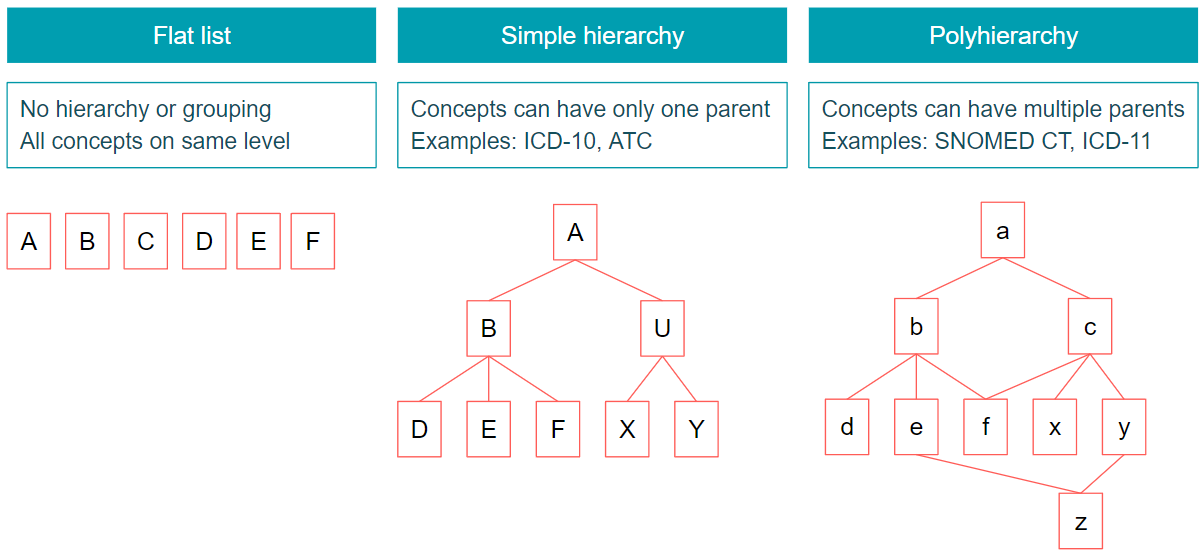Estonian Terminology Services Implementation Guide
1.0.0 - draft
Estonian Terminology Services Implementation Guide
1.0.0 - draft
Estonian Terminology Services Implementation Guide, published by TEHIK. This guide is not an authorized publication; it is the continuous build for version 1.0.0 built by the FHIR (HL7® FHIR® Standard) CI Build. This version is based on the current content of https://github.com/TEHIK-EE/TerminologyServices/ and changes regularly. See the Directory of published versions
There are many types of controlled vocabularies, and the distinction is not always clear. The following explanations highlight certain aspects, but don't provide full definition or an exhaustive classification for terminology assets.
Code list (et koodiloend) is a simple list of coded concepts to be used in a more or less specific context. Typically, code lists are quite implementation-specific, and used locally. A code list is an ambiguous term in FHIR context, because it can technically conveyed by a CodeSystem or ValueSet resource, or both. Most of Estonian health information system value sets are based on locally defined code lists, and are considered separate CodeSystems in FHIR context, because of collision of codes and concept meanings between different code lists.
Nomenclature (et nomenklatuur, sõnastik) is a controlled list of terms to be used in a certain field of science. Both, SNOMED CT and LOINC are called nomenclatures - they are different in their structure, but both aim to be exhaustive but never complete terminologies for their domain.
Ontology (et ontoloogia) is a controlled vocabulary where concepts are semantically defined/described through their relationships with other concepts from the same vocabulary. Unlike a thesaurus, an ontology is expected to be machine-readable and computable. The best known ontology is SNOMED CT. For example, for concept 75570004 Viral pneumonia (disorder), we have the information about the parents, but also the following lateral relationships (note, that the relationship attributes are also coded concepts):
363698007 Finding site (attribute) = 39607008 Lung structure (body structure),
116676008 Associated morphology (attribute) = 707496003 Inflammation and consolidation (morphologic abnormality),
370135005 Pathological process (attribute) = 441862004 Infectious process (qualifier value),
246075003 Causative agent (attribute) = 49872002 Virus (organism)
Classification (et klassifikaator or klassifikatsioon) is a finite list of concepts, designed to suit best for statistical use case, but often used also for clinical documentation. Classification is built on the closed world assumption, and even though they are updated like any other terminology asset, they aim to stay as stable as possible, and are therefore less flexible by design. Classifications inevitably contain so-called residue categories, because all concepts must fall under a category. The best known classifications in healthcare are the ones maintained by WHO: ICD-10 (et RHK-10), ICF (et RFK), ATC. For ICD-11 (et RHK-11), it is important to know, that while mortality and morbidity causes continue to be a classification, the foundation layer is planned to be closer to a nomenclature by nature.
A coded terminology can be a flat list, a simple hierarchy, or a polyhierarchy - each of these approaches have their pros and cons. Most value sets and simple lists of coded elements are represented as flat list. This approach is suitable when the list of concepts is relatively small. For bigger terminology systems, hierarchy is preferred. Classifications, designed primarily for health statistics, incline to use simple hierarchy (monohierarchy) where each concept can only have one parent. Clinical terminologies allow more flexibility and may use polyhierarchy, where a concept can have multiple parents.

From a technical (FHIR) point of view, monohierarchical parent-child relationshios can be conveyed in a nested structure, where child concepts are defined inside the parent concept. In a polyhierarchical structure, parent-child concept must be defined in a property/attribute.
Our long history of central terminology management has taught us the importance of metadata. Each terminology asset needs a periodic review, content quality control, a responsible decision maker, maintainer, publisher, etc. It is important to have an overview why the value sets were created, how are they intended to be used, who is authorised to update them, and which documents are they relevant for.
For each terminology asset, certain list of metadata is created (see the logical model in artifacts section of the IG). This metadata is published via terminology server as the terminology resource metadata. The metadata list (et klassifikaatori/koodiloendi pass) has been decided by the eHealth terminology coordination group run by the ministry of social affairs. This group is also responsible for validating requests for new classifications and code lists for national eHealth use cases. eHealth terminology management aims to follow the requirements set by the Statistics Board (Statistikaamet).
Most of TEHIK's value sets follow the same process for updating and publishing, even when the owners of the content differ. Value sets based on large international code systems (SNOMED CT, ATC) are dependent on the release cycles and content management of the underlying terminology systems.
While we're working on the process diagrams and new workflows, feel free to ask any questions about health information system code lists from andmekorraldus@tehik.ee
All SNOMED CT related questions are always welcome at snomed@tehik.ee
If you need linguistic help with Estonian clinical terminology, try using the health dictionary by Health Development Institute (TAI), or send them your question at medterm@tai.ee
More reading on theory: